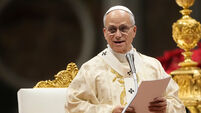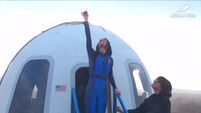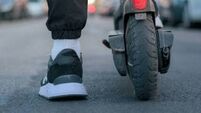Trail of the world's most wanted man grows cold
As Taliban defences around Kabul crumbled under the fury of American bombs, the man responsible for it all - Osama bin Laden - was far away in the safety of this mountain fortress.
Then, by the time the Americans zeroed in on Tora Bora in December, unleashing 15,000 pound bombs on the caves and tunnels, bin Laden was gone, according to his former driver, a Taliban regional security officer and the former chief of Taliban forces here in eastern Afghanistan.
Since then, the trail has gone cold. Sightings have been replaced by rumours, which variously report the elusive terrorist mastermind as dead or alive - either in the impenetrable Afghan mountains or in the tribal areas of western Pakistan.
An Afghan intelligence official, Rehmat Shah, said bin Laden was last sighted in June in Pakistan’s South Waziristan region, a rugged area along the border with Afghanistan where US special forces and Pakistani soldiers are searching for al-Qaida fugitives.
Although bin Laden’s current whereabouts are a mystery, former Taliban officials and others are now willing to talk about where he was around the time of the September 11 attacks.
"Immediately after September 11, Osama travelled around the country," said Mullah Mohammed Khaksar, who was the Taliban’s deputy interior minister at the time. "He didn’t stay in one place for more than 24 hours. He went to Kabul, Khost, Jalalabad, Uruzgan, Helmand, Jozjan, Faryab, Ghor and Badghis provinces, visiting the Arab camps. They were all over Afghanistan. Osama and the Arabs could move freely throughout Afghanistan."
After September 11, Khaksar said, the Taliban leadership was divided about the attacks in New York and Washington. He said most, if not all, of the senior Taliban figures had been unaware that the attacks had been planned since those close to bin Laden were all Arabs.
"Half of the Cabinet was happy and half of the Cabinet was not" because of fears of US reprisals, said Khaksar, who broke with the Taliban after it abandoned Kabul in November.
According to a retired Pakistani general bin Laden was at an al-Qaida camp in Bagran in Helmand province when the hijackers steered passenger planes into the Pentagon and the twin towers of the World Trade Centre.
The general, who was in Kandahar on September 11, said bin Laden’s whereabouts were relayed to him by senior Taliban officials.
When the US bombing began on October 7, bin Laden was in Kandahar along with Taliban supreme leader Mullah Mohammed Omar, according to Khaksar. Omar sent his family to Maruf, the Centre of his Hottaq tribe. Bin Laden’s family fled the country through Pakistan.
It’s unclear when bin Laden took refuge in Tora Bora, a complex of caves and tunnels south of Jalalabad near the Pakistani border that was a guerrilla refuge during the war against the Soviets in the 1980s.
However, Afghans in the area reported seeing "the sheik", as bin Laden was known, on November 19, three days after the Taliban abandoned Jalalabad, the capital of Nangarhar province.
An Afghan who described himself as bin Laden’s former driver said that four passports were brought to Jalalabad for the al-Qaida leader after September 11. The man said he believed the passports were provided by Pakistani intelligence but did not know the nationalities of the travel documents.
Maulvi Mohammed Towha, a senior Taliban security official, fled Jalalabad on November 16 along with the Taliban governor, Maulvi Abdul Kabir, who was also deputy prime minister. They were accompanied by about 2,500 men, including Arabs and Pakistanis from al-Qaida and its affiliated movements.
Some of the foreign fighters went northeast toward Kunar province and across the border into Pakistan, Towha said in Pakistan. Others went south and east toward Tora Bora.
Residents of villages around Tora Bora said hundreds of Arabs fled toward the mountain hide-outs. None, however, claimed to have seen bin Laden.
"So many Arabs came through here," said Mattiullah Khan, a resident of Bachir Akar in Nangarhar province. "People hid them. They were happy to hide them. For several days we kept them in our houses."
Most of the Arabs were believed to have fled the area before the heaviest of the US bombing, paying smugglers to guide them to Pakistan. From the caves of Tora Bora, the al-Qaida fighters and their families escaped through the villages of Suleiman Khiel and then to Milawa near the Pakistani border.
Despite a €23m price on his head, bin Laden would probably have had little to fear from Afghan villagers, whose culture considers handing over a "guest" to outsiders to be shameful.
"No one would have handed them over to America," said Najibullah, who uses only one name and lives in a mud brick hut near Tora Bora. "Lots of them came through here. Some were families, Afghans and Arabs."
Asked what happened to the Arabs, Najibullah gestured toward the mountain peaks. "Behind that mountain over there is Pakistan," he said. "All the women and children of the Arabs left to Pakistan."
Pakistani President Pervez Musharraf has said he believes bin Laden is dead. The US administration says it has no proof one way or the other. Many Afghans, especially bin Laden’s admirers, believe he survived.
"He is alive," said Fazul Rabi Said-Rahman, a former Taliban commander in eastern Afghanistan.
"We have our special way of knowing. He is not dead."














